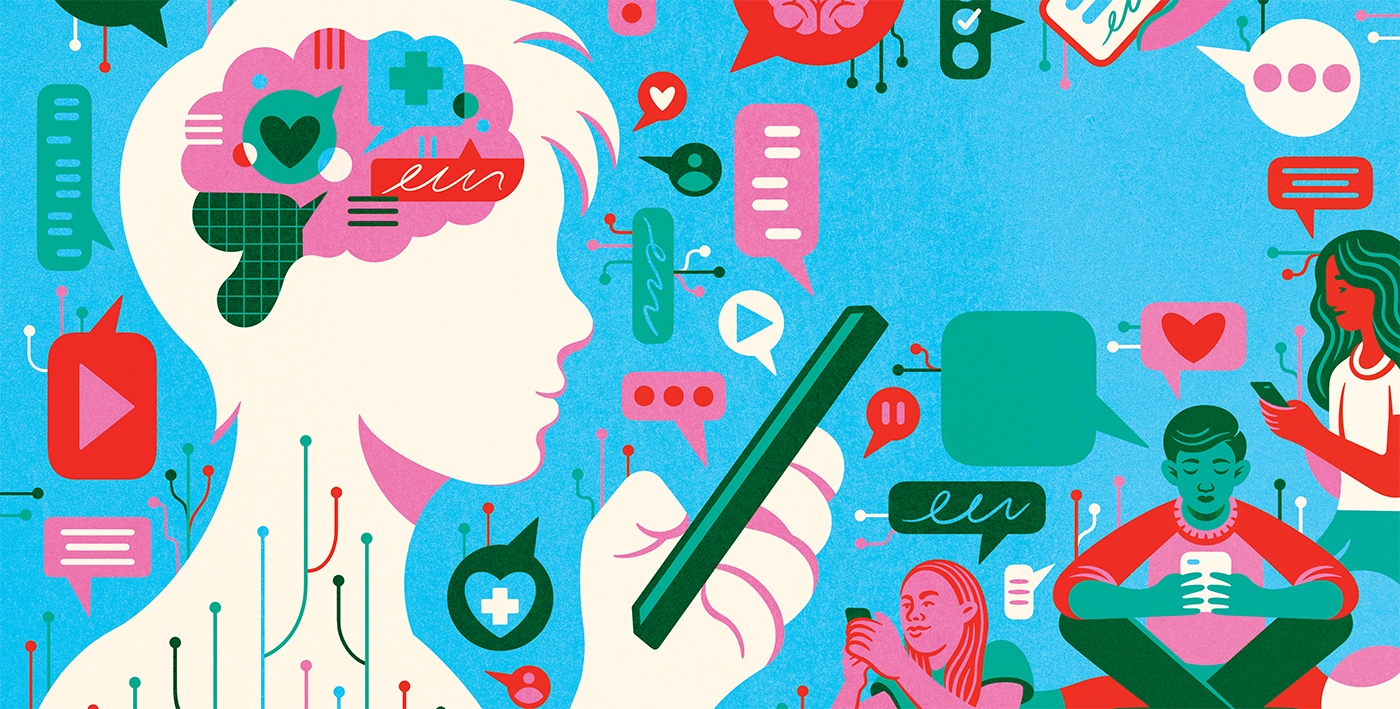
Making Social Media Safe
UW researchers are gaining insight into teens’ digital behavior and its effect on mental health.
Teens’ social media use is intense, and so is the hand-wringing it inspires. A majority use YouTube, TikTok, or both each day, and some do it “almost constantly,” according to a 2023 Pew Research Center study. Meanwhile, headlines sound the alarm about “social media addiction.”
Some health care organizations and news outlets frame overuse this way without unpacking what addiction truly means: an inability to stop doing something despite repeated negative consequences. And the hyperbole does teenagers no favors.
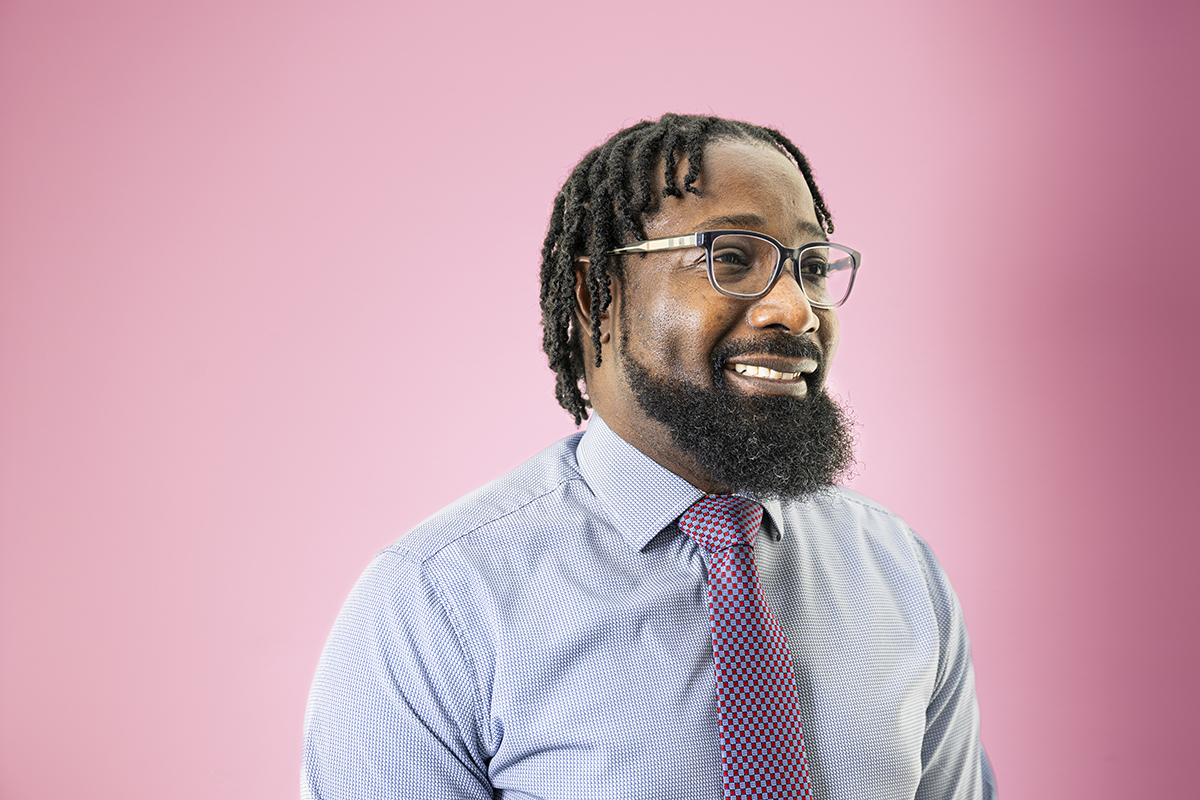
“Social media isn’t going anywhere, and fearing it won’t change that,” says UW associate professor Alvin Thomas. Bryce Richter
“It robs kids of their agency,” says Megan Moreno, a physician, professor, and interim chair of the pediatrics department at the UW School of Medicine and Public Health. “Sometimes we’re telling teens they’re addicted to social media rather than helping them find healthier ways of using it.”
What constitutes “unhealthy” use is an open question in academia, and social media’s upside — its capacity to foster mental health — has barely been studied. Moreno is one UW researcher seeking answers. Her latest project investigates how the social media content teens create and consume influences their beliefs and behavior. It’s funded by an $8 million grant from the Eunice Kennedy Shriver National Institute of Child Health and Human Development.
This grant also supports projects by UW pediatrics assistant professor Ellen Selkie MD’08, MPH’09 and Chris Cascio, an associate professor in the UW School of Journalism and Mass Communication. Other UW researchers are exploring the relationship between social media and teen mental health, as well as learning how adults should guide teens’ online experiences. Their findings have the potential to make the much-maligned social platforms a safer place for kids to hang out.
“Like Learning to Drive”
Moreno leads the Social Media and Adolescent Health Research Team, whose approach to digital safety research bridges public health, consumer science, and education. Its youth advisory board lets teens voice their perspectives on the studies.
The three studies funded by the Shriver grant share a cohort of 400 Wisconsin residents ages 13 to 15. Data are being gathered over two years, through surveys, interviews, text-messaged health screenings, and functional magnetic resonance imaging scans. The lab examines the teens’ actions and reactions on TikTok, Instagram, X, and Facebook.
“We observe what they choose to share about their health behaviors on social media, and whether what they share reflects or influences their actual intentions, attitudes, and behaviors,” Moreno says.
Data on how teens discuss healthy behaviors versus risky ones get linked to brain-imaging data from Cascio’s lab. Moreno has found that the teens’ posts are largely authentic, providing helpful clues for caregivers.
“I predict a strong positive association between what teens are posting about their behavior and what they’re actually doing, which has never been shown in this age group,” Moreno says, noting that data analysis is still underway.
As co–medical director of the American Academy of Pediatrics’ Center of Excellence on Social Media and Youth Mental Health, Moreno believes that adults, aided by research, can positively affect teens’ use of social media
“We need to think about social media like learning to drive,” she says. “You don’t put a teen in a car and say, ‘Figure it out.’ You ride with them, see how they’re doing, and teach them different parts of the process when they’re ready.”
Pain and Rewards
Cascio’s Communication, Brain, and Behavior Lab explores how persuasion influences adolescent health behaviors — for example, how teens’ real-world choices are shaped by peers’ digital actions. For their Shriver-funded study, the researchers are examining brain pathways associated with both the rewards and the social pain teens experience in the digital realm. They’re curious why some teen brains are more reactive to social inclusion and exclusion and how these differences influence mental health and behaviors such as vaping.
Though feeling a sense of reward with certain actions is part of the addiction process, it also drives many healthy habits. That’s one reason it’s unhelpful to generalize about “social media addiction.”
“It’s like saying alcohol is addictive,” Cascio says. “Addiction affects a subset of its users, but it doesn’t describe how everyone uses it.”
In other words, each teen’s social media experience is unique and has a different set of effects. Many teens report positive effects such as improved emotional health and feeling more supported socially. Despite this, other researchers tend to look for links between social media use and negative health outcomes, according to Cascio and Moreno. For the most part, the resulting advice has been to limit screen time — a generalization that leaves many parents feeling lost, guilty, or both.
Moreno argues that optimal amount of screen time will vary from teen to teen. That’s why she, Cascio, and Selkie are asking different questions about social media: why are some teens more vulnerable to harm, and what are the best ways to help them?
Cascio’s team suspects that the greater a teen’s exposure to certain types of social media experiences, the more sensitive to others’ opinions they’ll be. To test this hypothesis, they are measuring 150 eighth and ninth graders’ neural activity as they view social media posts. The teens see posts they’ve created and posts by others, rate how much they like or dislike each, and note how certain they feel about their like/dislike ratings.
“We’re seeing neural differences at work,” Cascio says. “For instance, experiencing more pain with self-posts is related to increased alcohol use. … It seems to drive health behaviors.”
The way the brain processes peer posts matters, too. Preliminary data analysis showed that teens who feel more reward during positive peer feedback are more likely to have used alcohol recently. Those who feel more pain during negative peer feedback have more intentions to vape.
“Sometimes we’re telling teens they’re addicted to social media rather than helping them find healthier ways of using it.”
The Communication, Brain, and Behavior Lab is collecting more data to see how these findings play out in different social situations, hoping to gain a clearer understanding of the relationship between reactivity and peer feedback. Armed with these findings, adults could offer support tailored to a teen’s information-processing style. For instance, a counselor might suggest different resources to teens who are easily influenced by peers’ social media behaviors and those who are not.
Social Media Personality Types
Selkie’s Learning More from Adolescents Online group is monitoring teen stress, loneliness, and self-esteem for a Shriver-funded project. The data help test a model in which childhood characteristics predict a trajectory of social media behavior in early adolescence, which then predicts socioemotional well-being indicators in middle adolescence.
The work involves identifying social media “personality types” associated with certain digital behaviors. For example, some types share many more details about their offline lives. Well-being markers get linked to each type.
“We watch how the content of each teen’s social media posts evolves over time, and this is enough to determine their type,” Selkie says. “Outcomes such as loneliness are likely to differ from one type to another.”
Knowing which styles are associated with risk helps mental health professionals develop better interventions.
Selkie’s team is also examining the social media experiences of transgender and nonbinary teens and their parents. The researchers hope to learn how the digital content they consume shapes their families’ health care decisions.
“We’re wondering what teens learn about gender from influencer content and how it affects their parents’ efforts to support their identities,” Selkie says.
Studies like these informed a recent White House roundtable where Moreno shared recommendations for making digital life more kid-safe. Selkie’s research will influence her clinical work as well.
“When you’re in an exam room, you may not see what’s impacting a teen’s mood,” Selkie says. “Research like this provides more context.”
Cyberbullying
Selkie began her research career with cyberbullying studies, extending findings by trailblazers like UW educational psychology professor Amy Bellmore. In addition to examining teens’ Twitter experiences in the platform’s early years, Bellmore pioneered cyberbullying research through a collaboration with UW computer sciences professor Jerry Zhu.
“Jerry Zhu heard about me through a colleague, then asked if I wanted to research cyberbullying with him, which is such a UW–Madison thing to do,” Bellmore says of the cross-disciplinary partnership. “I’d been studying bullying — but not cyberbullying — for 10 years and was ready for a new challenge.”
Bellmore’s team won a $500,000 National Science Foundation grant to develop machine-learning models that analyze social media data related to bullying. Between 2014 and 2018, they studied more than 500 teens’ Twitter posts, plus reports on their social media use and school experiences.
This research also deepened Bellmore’s interest in cross-cultural communication. Today, her Peer Relationships, Ethnicity, Schools, and Media Lab examines teens’ social media use through this lens. The lab is currently studying students at four high schools.
“We ask them whose social media posts they pay attention to and whose they interact with. They name these peers in their grade, and we evaluate those networks,” Bellmore says.
First the participants are divided into two groups: those naming more peers who share their own ethnic identity and those naming more peers with a different identity. Then the researchers compare and contrast.
Bellmore expects the data to mirror findings about offline peer interactions.
“Offline, ethnic minority students benefit from having more same-ethnicity peers, whether we’re looking at identity development or friendship quality,” she says. “Cross-ethnic interactions help students see other perspectives and perform better academically.”
If Bellmore’s hypothesis is correct, her research could fuel digital interventions for minority teens who feel marginalized. It could also shape schools’ efforts to boost grades and create a welcoming environment for all.
Preventing Negative Outcomes
Alvin Thomas, an associate professor of human development and family studies in the UW School of Human Ecology, compares social media to a playground: “You know your child could get hurt there, but preventing them from going would stymie their development. Instead, you teach them how to be safe.”
Social media’s upside — its ability to foster mental health — has barely been studied. UW researchers are filling the gap.
Racial discrimination is one injury teens of color can experience online. The likelihood grows as their social media use increases. The Thomas Resilient Youth Lab studies this phenomenon in its efforts to understand how social media shapes mental health.
In the lab’s study of social media use among 356 Black and Latino adolescents, teens who witnessed online racial discrimination reported more depression symptoms, and those who experienced it reported both anxiety and depression symptoms. Discrimination victims also reported more psychological distress, which was associated with feeling unable to act in academic domains. Having higher self-esteem tended to reduce this frozen feeling.
“To me, this means an excellent support system can be protective for a teen who’s been the target of online discrimination,” Thomas says.
Thomas expects to publish three related studies in 2025. Two explore how parents can protect teens from negative mental health outcomes after exposure to online racial discrimination. The other concerns compulsive internet use, whose negative mental health outcomes “aren’t as homogenous as one might assume.”
Finding ways to prevent negative outcomes, or decrease their impact, is the goal.
“Social media isn’t going anywhere, and fearing it won’t change that,” Thomas says. “When something negative happens, parents must recalibrate their teens’ perception of the world. Yes, the world’s dangerous, but it’s also full of beauty.” •
Jessica Steinhoff ’01 is a licensed psychotherapist who treats teens and young adults.
Published in the Winter 2024 issue
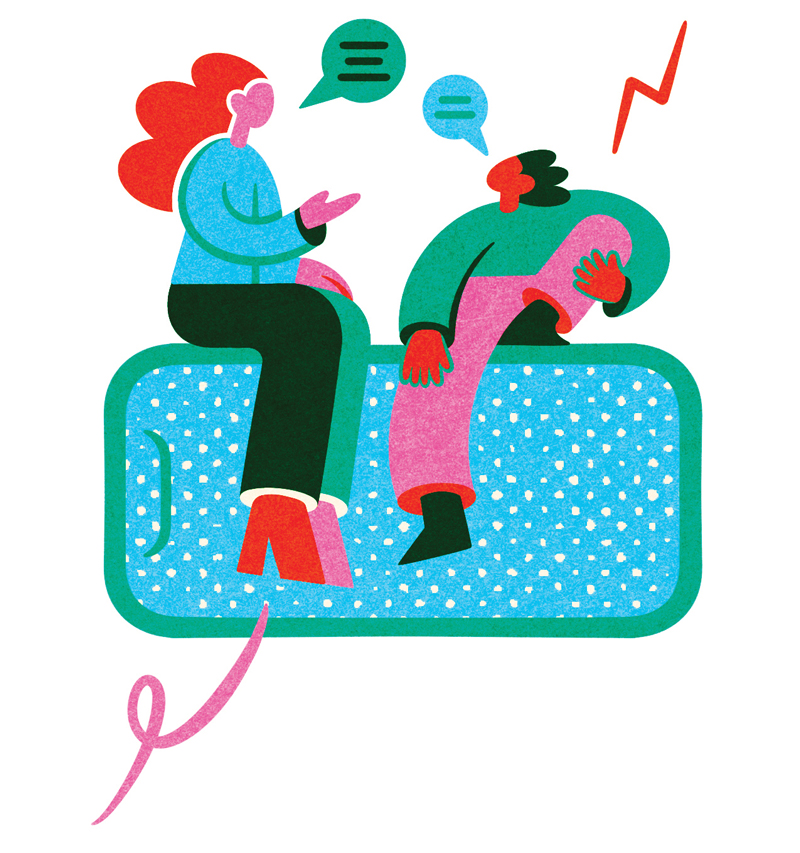
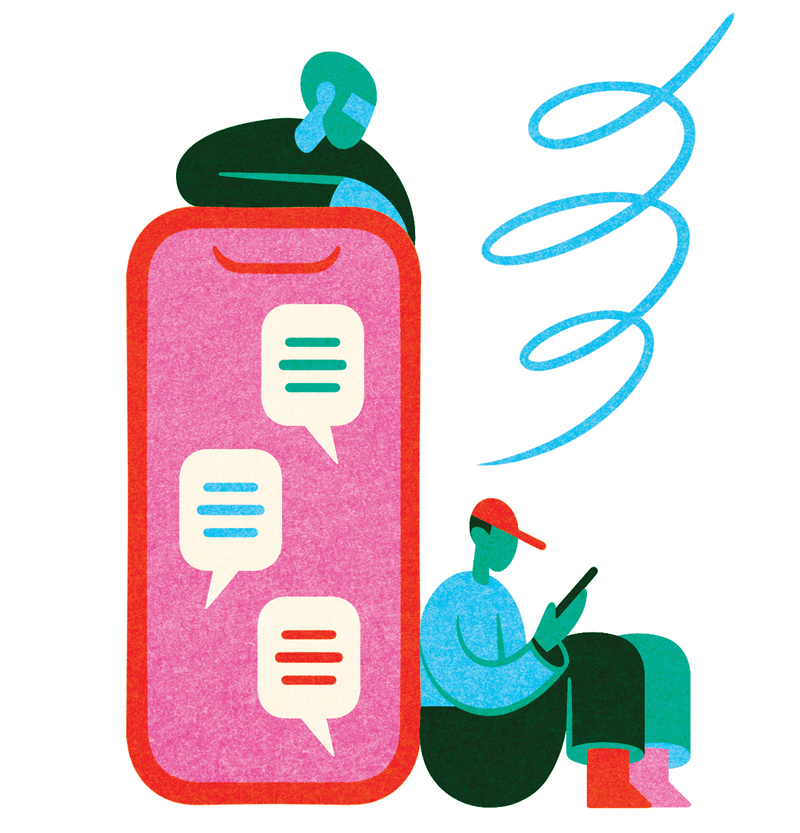
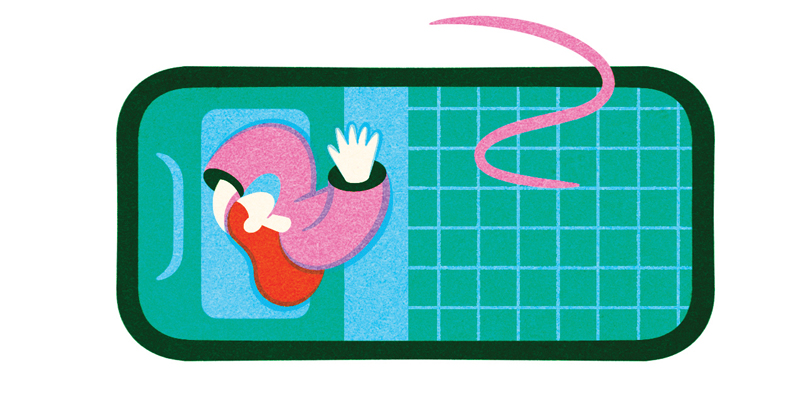
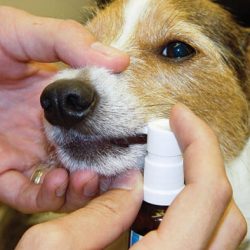


Comments
No comments posted yet.